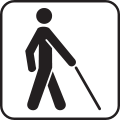
Back Gestremdheid Afrikaans Behinderung GSW Discapacitat AN Unmeaht ANG إعاقة Arabic প্ৰতিবন্ধকতা Assamese Discapacidá AST Əlillik Azerbaijani علیللیک AZB Зәғифлек Bashkir
| Disability |
|---|
|
|
Disability is the experience of any condition that makes it more difficult for a person to do certain activities or have equitable access within a given society.[1] Disabilities may be cognitive, developmental, intellectual, mental, physical, sensory, or a combination of multiple factors. Disabilities can be present from birth or can be acquired during a person's lifetime. Historically, disabilities have only been recognized based on a narrow set of criteria—however, disabilities are not binary and can be present in unique characteristics depending on the individual.[2] A disability may be readily visible, or invisible in nature.
The United Nations Convention on the Rights of Persons with Disabilities defines disability as including:
long-term physical, mental, intellectual or sensory impairments which in interaction with various barriers may hinder [a person's] full and effective participation in society on an equal basis with others.[3]
Disabilities have been perceived differently throughout history, through a variety of different theoretical lenses. There are two main models that attempt to explain disability in our society: the medical model and the social model.[4] The medical model serves as a theoretical framework that considers disability as an undesirable medical condition that requires specialized treatment. Those who ascribe to the medical model tend to focus on finding the root causes of disabilities, as well as any cures—such as assistive technology. The social model centers disability as a societally-created limitation on individuals who do not have the same ability as the majority of the population. Although the medical model and social model are the most common frames for disability, there are a multitude of other models that theorize disability.[5]
There are many terms that explain aspects of disability. While some terms solely exist to describe phenomena pertaining to disability, others have been centered around stigmatizing and ostracizing those with disabilities. Some terms have such a negative connotation that they are considered to be slurs.[6] A current point of contention is whether it is appropriate to use person-first language (i.e. a person who is disabled) or identity-first language (i.e. a disabled person) when referring to disability and an individual.
Due to the marginalization of disabled people, there have been several activist causes that push for equitable treatment and access in society. Disability activists have fought to receive equal and equitable rights under the law—though there are still political issues that enable or advance the oppression of disabled people. Although disability activism serves to dismantle ableist systems, social norms relating to the perception of disabilities are often reinforced by tropes used by the media. Since negative perceptions of disability are pervasive in modern society, disabled people have turned to self-advocacy in an attempt to push back against their marginalization. The recognition of disability as an identity that is experienced differently based on the other multi-faceted identities of the individual is one often pointed out by disabled self-advocates. The ostracization of disability from mainstream society has created the opportunity for a disability culture to emerge. While disabled activists still promote the integration of disabled people into mainstream society, several disabled-only spaces have been created to foster a disability community—such as with art, social media, and sports.
- ^ CDC (April 3, 2024). "Disability and Health Overview". Centers for Disease Control and Prevention. Retrieved April 24, 2024.
- ^ Francis L, Silvers A (October 1, 2016). "Perspectives on the Meaning of "Disability"". AMA Journal of Ethics. 18 (10): 1025–1033. doi:10.1001/journalofethics.2016.18.10.pfor2-1610. ISSN 2376-6980. PMID 27780027.
- ^ Resolution / adopted by the General Assembly, A/RES/61/106. UN General Assembly, Convention on the Rights of Persons with Disabilities. 24 January 2007. [accessed 27 December 2020]
- ^ "Medical and Social Models of Disability". Office of Developmental Primary Care. Retrieved February 8, 2024.
- ^ Wright KM (June 1, 2024). "Getting to Disability Justice: A Critical Conceptual Review of Disability Models in U.S. Social Work". The Journal of Sociology & Social Welfare. 51 (1): 70–81. doi:10.15453/0191-5096.4723. ISSN 0191-5096.
- ^ Barnes E (2014). "Valuing Disability, Causing Disability". Ethics. 125 (1): 88–113. doi:10.1086/677021. ISSN 0014-1704. JSTOR 10.1086/677021.


